10 Benefits Of Kimchi That You Must Know
Fermented foods are known for their immense health benefits, and this Korean dish is no exception.
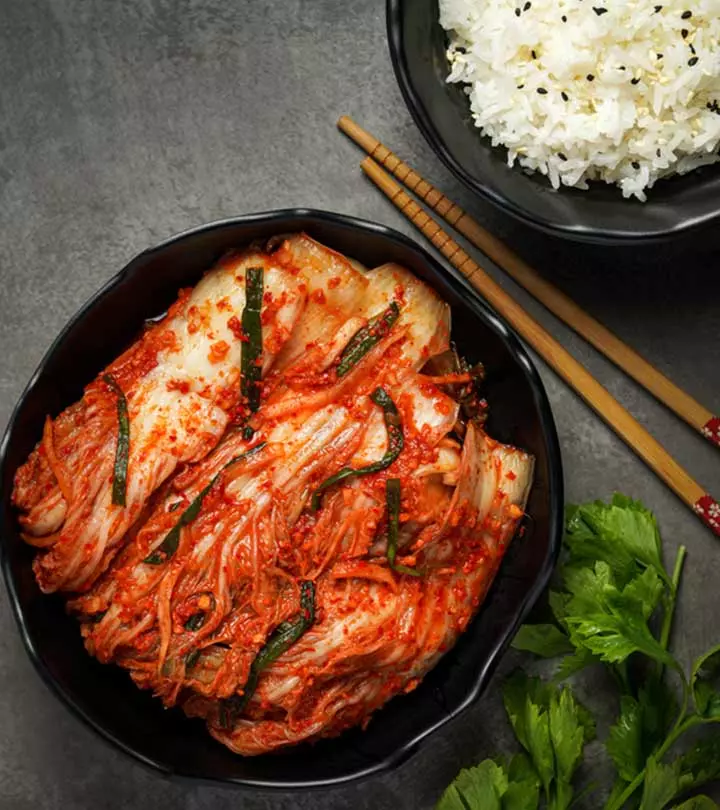
Image: Shutterstock
Kimchi is a staple Korean dish prepared from fermented cabbage and different spices. This traditional side dish has a spicy and sour flavor (which depends on the ingredients added and the method of preparation). The benefits of kimchi are numerous and may be attributed to its low calorific and high dietary fiber values. The bioactive compounds, antioxidants, and probiotics in kimchi help support gut health, enhance immune system function, and help with weight loss. This article explores kimchi nutrition profile, health benefits, the preparation method, and possible side effects. Keep reading.

In This Article
Kimchi Nutrition Facts
According to the U.S. Department of Agriculture, one cup (150g) of kimchi contains (1):
Calories | 22.5 |
Protein | 1.65 g |
Fat | 0.75g |
Carbohydrate | 3.6g |
Fiber | 2.4g |
Sugars | 1.59g |
Calcium | 49.5 mg |
Iron | 3.75 mg |
Magnesium | 21 mg |
Phosphorous | 36 mg |
Potassium | 226 mg |
Sodium | 747 mg |
Niacin | 1.65 mg |
Riboflavin | 0.315 mg |
Folate | 78 µg |
These nutrients make kimchi a highly beneficial food. In the next section, we bring to you a list of kimchi varieties.
Key Takeaways
- Kimchi provides fewer calories and is a rich source of fiber, calcium, potassium.
- HDMPPA, an active compound in kimchi, has anti-inflammatory and antioxidant properties that may help reduce the risk of several diseases.
- Fermented foods like kimchi are replete with probiotics that promote gut health.
- Moreover, studies suggest that kimchi helps reduce body fat and is good for individuals who are obese or overweight.
Types Of Kimchi
Kimchi is traditionally made from fermented cabbage. However, you can use different vegetables like cucumbers, radish, carrots, and onions as well. Listed below are a few varieties of kimchi.
- Baechu (cabbage) kimchi – Korean Buddhist style
- Napa cabbage kimchi
- Bossam (wrapped) kimchi
- Gat (mustard) kimchi
- Dongchimi (radish water) kimchi
- Nabak (red water) kimchi
- Oi sobagi (cucumber) kimchi
- Chonggak (ponytail radish) kimchi
- Kkakdugi (cubed radish) kimchi
- Baek (white) kimchi
 Trivia
TriviaHealth Benefits Of Kimchi
1. May Improve Gut Health
Fermented foods like kimchi contain lactic acid bacteria (LAB), which have probiotic properties (2). Probiotic-rich foods may improve gut bacteria and enhance digestive health (3). Besides, an increased intake of fermented foods was found to improve intestinal health, treat infectious diarrhea, and reduce inflammation (4). A study conducted by Hiroshima University (Japan) found that the probiotic activity of lactic acid bacteria may also help treat constipation (5). Another study suggests that lactobacillus strains found in kimchi have antimicrobial activity against food-borne pathogens (6). Moreover, probiotics may also be beneficial in treating and preventing gastrointestinal diseases (7). Adding fermented foods like kimchi to your diet can help reduce gastrointestinal disorders like irritable bowel syndrome and colon inflammation symptoms. Maintaining a healthy gut flora is important for overall health.
2. Has Anti-Inflammatory Properties
HDMPPA, an active compound in kimchi, may help reduce inflammation (8), (9). Besides, Lactobacillus paracasei, a lactic acid bacterium isolated from kimchi, exhibits a similar effect and helps relieve colitis (inflammatory reaction in the colon) symptoms (10). The bioactive compounds in kimchi may also help reduce the symptoms of Alzheimer’s disease by suppressing inflammation (11).
3. May Boost The Immune System
A 17-week study showed that probiotics found in foods like kimchi can boost immune health (12). These immune-regulating probiotics include Lactobacillus sakei and Lactobacillus plantarum (13), (14). However, more studies are warranted to understand this benefit of kimchi.
4. May Help With Weight Loss
Consuming kimchi was found to reduce bodyweight in overweight and obese individuals. In fact, fermented variety had shown more significant results than fresh kimchi (15). Furthermore, a study conducted on 114 adults for 12 weeks found that L. sakei present in kimchi may help reduce body fat in people with obesity (16). Besides, the low calorific value of this Korean dish may also contribute to weight loss. Another study by Ajou University School of Medicine (Republic of Korea) indicated that kimchi may improve metabolic rates (17).
5. May Improve Heart Health
HDMPPA, the bioactive compound in kimchi, has antioxidant and anti-atherosclerotic effects. These properties may help reduce the risk of heart disease (18). Besides, fermented kimchi was found to have more beneficial effects than the fresh variety on factors associated with cardiovascular diseases (19). Furthermore, kimchi may also decrease LDL cholesterol and serum triglyceride levels (20). A study found that mice fed with kimchi had lower fat levels than those given a high cholesterol diet (21). In addition, the anti-inflammatory properties of kimchi may help reduce the risk of heart diseases (22), (23).
6. Helps Regulate Blood Sugar Levels
A pilot study conducted on 21 individuals with prediabetes found that kimchi intake may improve glucose tolerance and lower fasting blood glucose levels. The fermented dish may also increase insulin sensitivity and lower blood pressure (17), (24). Another study on rats conducted by the Seoul National University (Republic of Korea)found that dietary baechu kimchi has anti-diabetic effects. Kimchi was found to protect against diabetes even when the rats were fed a high-fat diet. However, consume kimchi with a low or normal fat diet for better results (25). Insufficient Evidence For
7. May Prevent Yeast Infections
Lactobacillus strains that are isolated from kimchi have probiotic, anti-inflammatory, and antimicrobial properties. Their basic probiotic functions include breaking down (hydrolase activity) bile salts, producing hydrogen peroxide, and resisting heat at 70oC for 60 seconds. These strains help treat infections caused by Candida albicans and Gardnerella vaginalis species (26), (27). Their anti-inflammatory properties may help treat and prevent bacterial vaginosis (bacterial overgrowth in the vagina) and vulvovaginal candidiasis (a yeast infection of the vagina). Besides, Lactobacillus bacterium was also demonstrated to improve mucosal health.
8. May Protect Against Oxidative Stress
Kimchi added with black raspberry juice powder is a rich source of antioxidants, which may help protect the cells from oxidative damage (28). This traditional side dish may also protect the liver from oxidative effects. Besides, methanol extracts of kimchi also possess radical scavenging ability. In a study, over-ripened kimchi had shown the strongest antioxidant activity compared to fresh and optimally ripened kimchi (29).
9. May Have Anti-Aging Properties
Kimchi may exhibit anti-aging potential. Its anti-inflammatory and radical-scavenging activities may help slow down aging by regulating genes (30). In addition, oral administration of Lactobacillus strains from kimchi was found to prevent atopic dermatitis (red and itchy skin) in mice models (31).
10. May Have Anti-Cancer Potential
The bioactive compounds in kimchi, like beta-sorbitol, have anti-cancer potential (32).The anti-inflammatory, antioxidative, and anti-mutagenic properties of kimchi may also help treat cancer. However, more research is warranted to understand this activity of kimchi. Consuming anything in excess may lead to undesirable effects, and so is the case with kimchi. Continue reading to learn about the side effects of excess kimchi intake.
Side Effects Of Kimchi
Consuming kimchi is generally considered safe. However, kimchi products made using contaminated groundwater (high chlorine content) may cause acute gastroenteritis (an intestinal infection) in some individuals (33). Besides, kimchi intake may also cause food-borne illnesses in some people (34). It is important to prepare and store kimchi appropriately to avoid the growth of pathogenic bacteria (35). Besides, the high sodium content in kimchi is linked with blood pressure and may not be suitable for people with heart disease. This Korean staple may also cause bloating or an upset stomach due to its high levels of probiotics. Kimchi has a very good commercial presence. However, you can also prepare this side dish at home.
How To Prepare Kimchi Easily At Home?
What You Need
- Napa cabbage – 2 medium heads (6-8 pounds)
- Coarse salt – 1½ cups
- Coldwater – 1 gallon + ½ cup
- Green onions – 10
- Sweet rice flour – 2 tablespoons
- Garlic – 1-10 cloves
- Ginger root – 3 slices
- Korean red pepper powder – 1 cup
- Korean or daikon radish – 1-1½ pounds
- Fish sauce – 1 teaspoon (optional)
- Finely ground salt – 2 teaspoons
Process
1. Prepare Napa cabbage.
a. Rinse heads under cold water and drain. b. Cut away spoiled or damaged spots. c. Cut Napa cabbage into quarters and remove the core from each. Chop the quarters into 2-inch pieces.
2. Prepare salt cabbage
a. Prepare a saltwater solution of ½ cup coarse, non-iodized salt, and 1-gallon cold water in a large mixing bowl. b. Dip cabbage pieces briefly in the solution. c. Drain and place the cabbage pieces in a bowl. Sprinkle 1 cup of non-iodized salt over them and massage well. Cover the bowl and leave them at room temperature for 3 to 6 hours (a longer duration will make it saltier). d. Wash the cabbage pieces 3 to 4 times with cold water to rinse off the salt. Place them in a colander for at least 30 minutes to drain excess water.
3. Prepare seasonings
a. Add sweet rice flour to ½ cup water in a small saucepan. Bring to a boil and set aside to cool. b. Peel and finely mince (or use a blender with a small amount of water) the garlic and ginger. Mix with the flour paste and add Korean red pepper powder. c. Trim green onions, and peel radish and Asian pear (if desired). Cut them all in Julienne style or into matchsticks about 1 inch in length. d. Put on disposable food handler gloves, and mix the seasoning paste and Julienned vegetables in a large bowl. Add fish sauce and mix to create a spicy veggie paste. Add salt as needed. e. Combine the cabbage with the spicy veggie paste and mix well. 4. Pack kimchi tightly into a container, minimizing air exposure and encouraging brine formation. Fill the container until 2/3rd and cover tightly. 5. Place in the refrigerator and let it ferment for 3 to 4 days. This may be preferred especially during hot weather. You can also place the container in a well-ventilated location with a relatively constant room temperature (around 68°F). Ferment only 1 to 2 days at room temperature, tasting it daily until it reaches the preferred tangy taste and desired texture. 6. Cover fermented kimchi tightly and store in the refrigerator. Kimchi may become sourer over time. Discard if you observe surface mold. Note: Kimchi can also be eaten fresh without fermentation. You can eat kimchi as it is or as a side dish. You can also use it as an ingredient in other dishes. Here are some ways to enjoy kimchi in your diet.
How To Include Kimchi In Your Diet?
- Stir into your fried rice.
- Serve on top of a grain bowl.
- Use as a filling in an omelet.
- Use in potato pancakes or scallion fritters.
- Use inside burritos and Korean-style tacos.
- Try with eggs.
- Add to noodle dishes like ramen, udon, and soba.
- Use to flavor soup broth or stew.
Note:
Heating any fermented food can kill the healthy probiotics. Hence, add kimchi at the end of the cooking process. What are the easiest and healthiest kimchi recipes to try at home? Keep scrolling to find out.
3 Easy Kimchi Recipes To Try
1. Kimchi Soup
WhatYou Need
- Chopped kimchi – 2 cups
- Water – 5 cups
- Pork shoulder – ½ a pound
- Hot pepper paste – 2 tablespoons
- Sugar – 1 teaspoon
- Chopped green onions – 2 stalks
- Tofu – 1 pack (14 ounces)
Process
1. Combine the kimchi, hot pepper paste, kimchi juice, pork, and sugar in a heavy-bottomed pot. 2. Add water and bring to a boil over high heat. Cook for 30 minutes. 3. Add tofu and lower the heat to medium-low. Cook for another 10 minutes. 4. Add green onion and turn off the stove. 5. Serve hot with rice and a few more side dishes if desired.
2. Kimchi Salad
What You Need
- Shredded cabbage – 1 small head
- Rock salt – ¼ cup
- Vegetable oil – 2 tablespoons
- Vinegar – 3 tablespoons
- Carrot – 1
- White sugar – 1 tablespoon
- Sesame seeds, toasted – 1 teaspoon
- Sesame oil – 1 teaspoon
- Cayenne pepper – ½ teaspoon
- Salt – ¼ teaspoon
Process
1. Mix cabbage and rock salt in a bowl. 2. Let it stand for 15 minutes, stirring often. 3. Rinse lightly and drain. 4. Mix cabbage, carrot, vinegar, vegetable oil, sugar, sesame oil, sesame seeds, cayenne pepper, and salt in a bowl. 5. Refrigerate until chilled (at least 30 minutes).
3. Kimchi Fried Rice
What You Need
- Roughly chopped kimchi – 1 cup
- Kimchi juice – 2 tablespoons
- Cooked meat – ½ cup
- Onion – ½
- Unsalted butter – 3 tablespoons
- Cooked and cooled rice – 2 cups
- Soy sauce – 2 teaspoons
- Vegetable oil – 2 teaspoons
- Sesame oil – 1 teaspoon
- Eggs – 2
- Salt – to taste
- Sesame seeds – for garnish
- Crumbled or silvered nori – for garnish
Process
1. Melt butter over medium-low heat in a nonstick sauté pan or well-seasoned cast-iron skillet. Sauté onions for about 2 minutes. 2. Add kimchi and kimchi juice, and stir until it comes to a boil (about 3 minutes). Add spam (spiced ham or cooked meat) and cook (about 5 minutes) until the sauce is nearly dried out. 3. Break up the rice in the pan with a spatula and stir. 4. Turn the heat to medium. Cook, stirring, until the rice has absorbed the sauce (about 5 minutes). 5. Stir in soy sauce and sesame oil. 6. Taste and adjust with more soy sauce, sesame oil, or kimchi juice. 7. Turn the heat to low. Let the rice continue to cook (untouched) until it turns light brown. 8. Meanwhile, add the vegetable oil to a small nonstick sauté pan over medium heat. 9. Add the eggs, season with salt, and fry to your desired doneness. 10. Serve rice topped with fried eggs, nori, and a sprinkle of sesame seeds.
4. Kimchi Grilled Cheese Sandwich
What You Need
- Kimchi- 1/2 cup (chopped)
- Cheddar Cheese – 1 cup (shredded)
- Bread slices- 4
- Butter- 2 tablespoons
Process
- Spread butter on one side of each bread slice.
- Place a slice with the buttered side down on a skillet over medium heat.
- Place a layer of cheddar cheese on the bread.
- Top with a generous amount of chopped kimchi.
- Add another layer of cheddar cheese and cover with a second slice of bread, buttered side up.
- Grill until the bread is golden brown and the cheese is melted.
- Flip and cook the other side until it achieves the same golden brown perfection.
- Repeat for the remaining slices.
- Slice and serve your flavorful Kimchi Grilled Cheese Sandwich.
 Did You Know?
Did You Know?How To Store Kimchi?
Store-bought kimchi can be kept at room temperature for up to a week after unsealing it. Keep it in the refrigerator if you want to store it for three to six months. Always handle kimchi with clean utensils to avoid spoilage.
Frequently Asked Questions
Is it okay to eat kimchi every day?
Yes, kimchi can be consumed every day. However, the quantity should only be limited to 100 grams per day.
What does kimchi taste like?
Kimchi has a typical sour taste, as it is a fermented food.
Does cooked kimchi still have probiotics?
If kimchi reaches a temperature of 115°F while cooking, it may lose its probiotics. Hence it is generally not recommended to cook kimchi.
Does kimchi have vitamin C?
Yes, kimchi has a decent amount of vitamin C.
Can you eat too much kimchi?
No, consuming kimchi in excess is not recommended. It may cause gastrointestinal discomfort, and bloating and may negatively affect digestion.
Is kimchi high in salt?
Yes, kimchi is high in salt. Adding salt helps in the preservation of the kimchi.
Kimchi is a traditional Asian dish that has recently gained popularity due to its tantalizing taste and many health benefits. This video explores its potential impact on allergies and intestinal health, backed by scientific evidence. Click play to know more.
References
Articles on StyleCraze are backed by verified information from peer-reviewed and academic research papers, reputed organizations, research institutions, and medical associations to ensure accuracy and relevance. Read our editorial policy to learn more.
- Cabbage kimchi https://fdc.nal.usda.gov/fdc-app.html#/food-details/170392/nutrients
- Health benefits of kimchi (Korean fermented vegetables) as a probiotic food https://pubmed.ncbi.nlm.nih.gov/24456350/
- Does Consumption of Fermented Foods Modify the Human Gut Microbiota? https://pubmed.ncbi.nlm.nih.gov/32232406/
- Yogurt and other fermented foods as sources of health-promoting bacteria https://pubmed.ncbi.nlm.nih.gov/30452699/
- Improvement of constipation and liver function by plant-derived lactic acid bacteria: a double-blind randomized trial https://pubmed.ncbi.nlm.nih.gov/19628371/
- Functional properties of Lactobacillus strains isolated from kimchi https://pubmed.ncbi.nlm.nih.gov/21215484/
- A meta-analysis of probiotic efficacy for gastrointestinal diseases https://pubmed.ncbi.nlm.nih.gov/22529959/
- Beneficial effects of the active principle component of Korean cabbage kimchi via increasing nitric oxide production and suppressing inflammation in the aorta of apoE knockout mice https://pubmed.ncbi.nlm.nih.gov/22715945/
- Anti-Inflammatory Effects of 3-(4\’-Hydroxyl-3\’5\’-Dimethoxyphenyl)Propionic Acid an Active Component of Korean Cabbage Kimchi in Lipopolysaccharide-Stimulated BV2 Microglia https://pubmed.ncbi.nlm.nih.gov/25919915/
- A lactic acid bacterium isolated from kimchi ameliorates intestinal inflammation in DSS-induced colitis https://pubmed.ncbi.nlm.nih.gov/28124779/
- Bioactive Compounds in Kimchi Improve the Cognitive and Memory Functions Impaired by Amyloid Beta https://pubmed.ncbi.nlm.nih.gov/30347786/
- Gut-microbiota-targeted diets modulate human immune status https://pubmed.ncbi.nlm.nih.gov/34256014/
- Different immune regulatory potential of Lactobacillus plantarum and Lactobacillus sakei isolated from Kimchi https://pubmed.ncbi.nlm.nih.gov/25112321/
- Antioxidant and immune-enhancing effects of probiotic Lactobacillus plantarum 200655 isolated from kimchi https://www.ncbi.nlm.nih.gov/labs/pmc/articles/PMC6431328/
- Fermented kimchi reduces body weight and improves metabolic parameters in overweight and obese patients https://pubmed.ncbi.nlm.nih.gov/21745625/
- Effect of Lactobacillus sakei a Probiotic Derived from Kimchi on Body Fat in Koreans with Obesity: A Randomized Controlled Study https://www.ncbi.nlm.nih.gov/labs/pmc/articles/PMC7386112/
- Beneficial effects of fresh and fermented kimchi in prediabetic individuals https://pubmed.ncbi.nlm.nih.gov/23969321/
- Beneficial Effects of Kimchi a Korean Fermented Vegetable Food on Pathophysiological Factors Related to Atherosclerosis https://pubmed.ncbi.nlm.nih.gov/29271694/
- Fermented kimchi reduces body weight and improves metabolic parameters in overweight and obese patients https://www.sciencedirect.com/science/article/abs/pii/S027153171100114X?via%3Dihub
- Kimchi a Fermented Vegetable Improves Serum Lipid Profiles in Healthy Young Adults: Randomized Clinical Trial https://www.ncbi.nlm.nih.gov/labs/pmc/articles/PMC3598433/
- Preventative activity of kimchi on high cholesterol diet-induced hepatic damage through regulation of lipid metabolism in LDL receptor knockout mice https://www.ncbi.nlm.nih.gov/labs/pmc/articles/PMC6049760/
- Linking Chronic Inflammation with Cardiovascular Disease: From Normal Aging to the Metabolic Syndrome https://pubmed.ncbi.nlm.nih.gov/28670620/
- Kimchi and Other Widely Consumed Traditional Fermented Foods of Korea: A Review https://www.ncbi.nlm.nih.gov/labs/pmc/articles/PMC5039233/
- Kimchi a fermented vegetable improves serum lipid profiles in healthy young adults: randomized clinical trial https://pubmed.ncbi.nlm.nih.gov/23444963/
- Antidiabetic effect of Korean traditional Baechu (Chinese cabbage) kimchi in a type 2 diabetes model of rats https://pubmed.ncbi.nlm.nih.gov/19459728/
- Whole Genome Analysis of Lactobacillus plantarum Strains Isolated From Kimchi and Determination of Probiotic Properties to Treat Mucosal Infections by Candida albicans and Gardnerella vaginalis https://pubmed.ncbi.nlm.nih.gov/30894844/
- Anti-inflammatory effect of two Lactobacillus strains during infection with Gardnerella vaginalis and Candida albicans in a HeLa cell culture model https://pubmed.ncbi.nlm.nih.gov/29458690/
- Antioxidant effects of kimchi supplemented with black raspberry during fermentation protect against liver cirrhosis-induced oxidative stress in rats https://www.ncbi.nlm.nih.gov/labs/pmc/articles/PMC6449543/
- Antioxidative effects of Kimchi under different fermentation stage on radical-induced oxidative stress https://www.ncbi.nlm.nih.gov/labs/pmc/articles/PMC4252523/
- Anti-aging effects and mechanisms of kimchi during fermentation under stress-induced premature senescence cellular system https://link.springer.com/article/10.1007/s10068-011-0091-9
- Oral administration of Lactobacillus strains from Kimchi inhibits atopic dermatitis in NC / Nga mice https://pubmed.ncbi.nlm.nih.gov/21338447/
- Kimchi and an active component beta-sitosterol reduce oncogenic H-Ras(v12)-induced DNA synthesis https://pubmed.ncbi.nlm.nih.gov/14585179/
- Three gastroenteritis outbreaks in South Korea caused by the consumption of kimchi tainted by norovirus GI.4 https://pubmed.ncbi.nlm.nih.gov/25764445/
- Outbreak of enterotoxigenic Escherichia coli O169 enteritis in schoolchildren associated with consumption of kimchi Republic of Korea 2012 https://pubmed.ncbi.nlm.nih.gov/23800632/
- Kimchi and Other Widely Consumed Traditional Fermented Foods of Korea: A Review https://www.ncbi.nlm.nih.gov/labs/pmc/articles/PMC5039233/
Read full bio of Mayuri Aavula
Read full bio of Sindhu Koganti
Read full bio of Ravi Teja Tadimalla
Read full bio of Himanshi Mahajan


















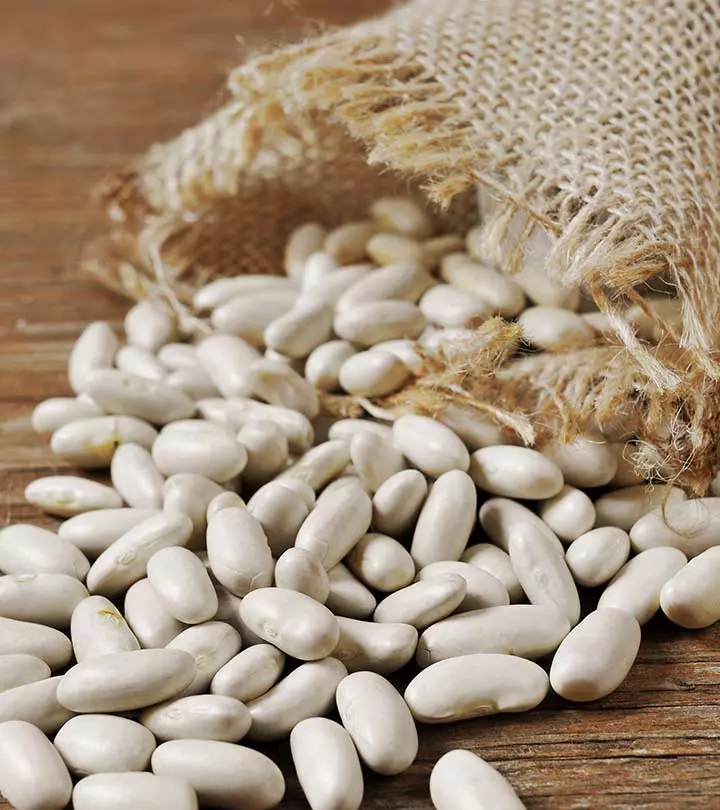

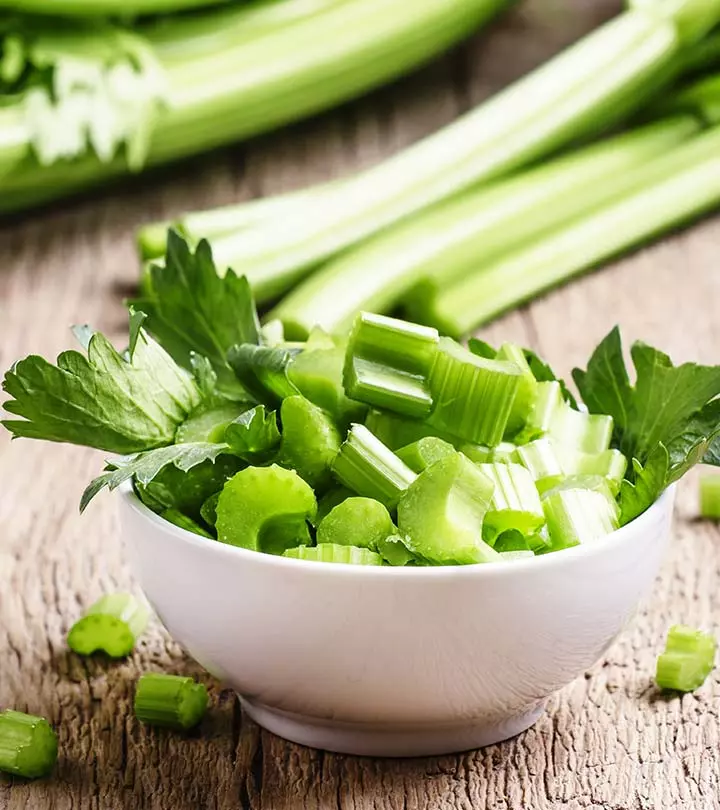

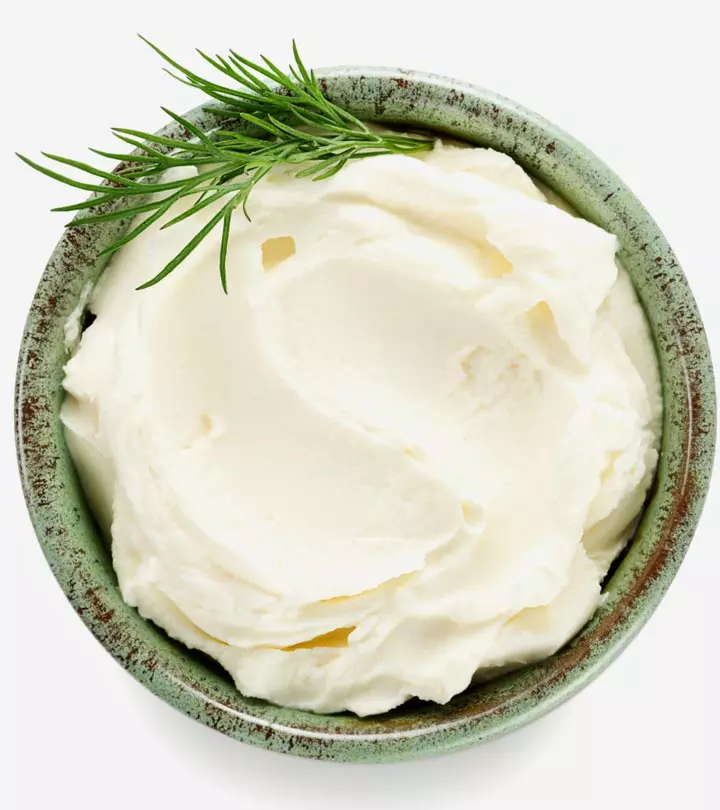


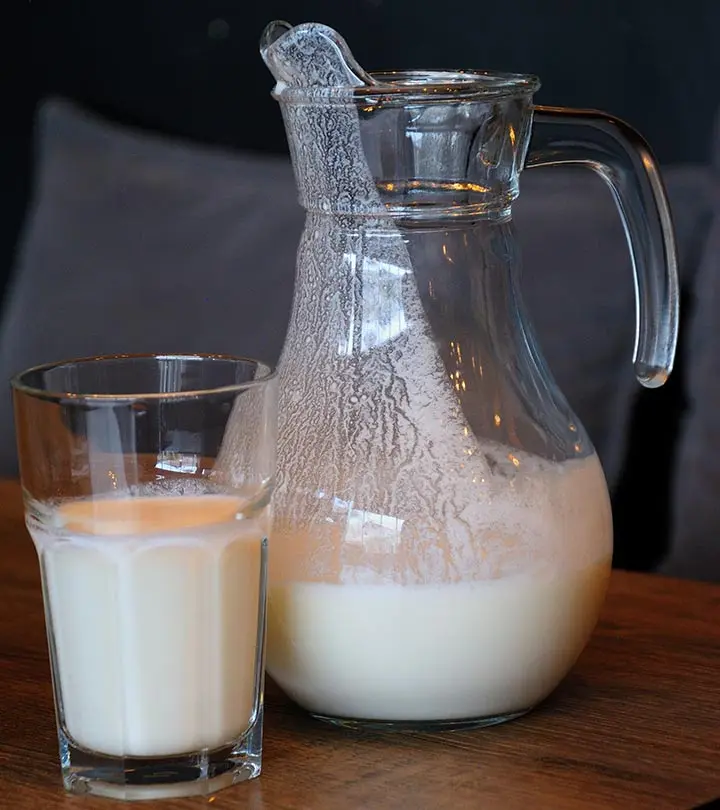

Community Experiences
Join the conversation and become a part of our empowering community! Share your stories, experiences, and insights to connect with other beauty, lifestyle, and health enthusiasts.